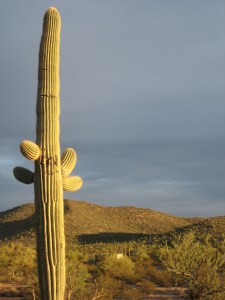
This photo shows a crested saguaro on the left. The saguaro on the right is what we are more accustomed to when we think of saguaros.
I’d seen old photos of crested saguaros and heard about them during a visit to the Organ Pipe Cactus National Monument, but I’d never seen one in person. When I mentioned to Coyote Sue that The Man and I would take Highway 86 through Tohono O’odham Nation land when we traveled from Tucson to Ajo, she told me there were two crested saguaros growing close to the road along that route. She couldn’t remember exactly where the crested saguaros stood, but she put me on the alert to look for them and gave me a good idea of where to find them.
Why do crested saguaros grow the way they do? Nobody knows! According to https://www.nps.gov/sagu/learn/nature/why_crested.htm,
Saguaros sometimes grow in odd or misshapen forms. The growing tip occasionally produces a fan-like form which is referred to as crested or cristate…Biologists disagree as to why some saguaros grow in this unusual form. Some speculate that it is a genetic mutation. Others say it is the result of a lightning strike or freeze damage. At this point we simply do not know what causes this rare, crested form.
The first crested saguaro I spotted stands between mileposts 96 and 97 on the north side of Highway 86. It’s just past a driveway leading to a small building. A wire fence separates the saguaro from the road.
The second crested saguaro is west of the first one. I forgot to note the mile marker numbers closest to it (dang!) but it’s also on the north side of the highway, and a wire fence also separates the saguaro from the road.
The Man thought the first crested saguaro was the better looking of the two we saw. In fact, he didn’t even bother taking a photo of the second one because he thought it paled in comparison to the first. On the other hand, I thought the second crested saguaro was a better specimen. The crest of the second one reminded me of a rooster’s comb and
wasn’t as bunchy and bumpy as the crest on the first one. Well, to each our own!
I feel very lucky to have finally seen a crested saguaro growing wild and free. My Sonoran Desert experience is now a bit more complete.
Which of the two crested saguaros pictured in this post do you like the best? Share your choice by leaving a comment below.
I took all of the photos in this post.











